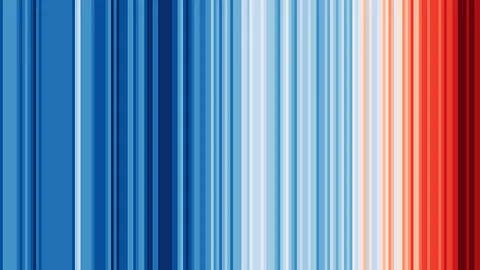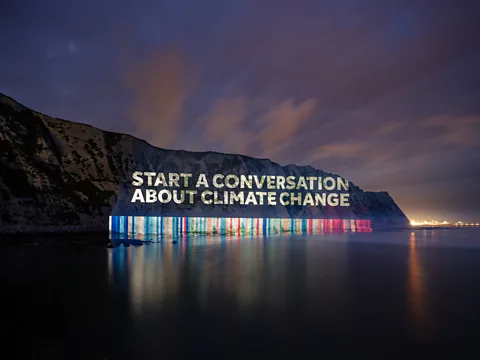The coloured stripes that explain climate change
 Ed Hawkins, University of Reading
Ed Hawkins, University of ReadingFive years ago a simple design – stripes of colours ranging from dark blue to dark red – started a universal and revolutionary way of communicating global warming.

In 2017, Ellie Highwood, then professor of climate physics at the University of Reading, posted a photograph on Twitter of a "global warming blanket" she had crocheted, in which rows of colour represented average global temperature changes across time. She had no idea that a graphic version later created by a colleague would become a global symbol of climate change.
The "climate stripes" image has been embraced by activists globally, and used as a cover image for Greta Thunberg's The Climate Book, as well as for print editions of The Economist and the Folha de S.Paulo, a Brazilian newspaper. The stripes have been worn in London Fashion Week catwalks and as part of the UK football team Reading FC’s players' uniform.
A new colour for climate change
The climate stripes graphic needs updating as global temperatures were so hot in 2023, says its creator, climate scientist Ed Hawkins, in January 2024.
The darkest red shown on the current scale does not accurately reflect the current state of the climate, Hawkins says. "2023 was off the end of the scale." 2023 was the warmest year on record. Hawkins says there was always going to be a new colour, but says "the margin of record breaking in 2023 has still been a surprise".
The stripes have been displayed as public infrastructure, on public transport in Europe, decorated buildings and even natural landmarks such as the White Cliffs of Dover in England. Recently, they were shown in a three day music festival in Mexico City.
Cycling 4 Climate, a foundation that has organised rides in six countries to promote climate change awareness, chose the stripe pattern as a uniform because of the strong message it conveys.
"It gives me the feeling that even when I'm exercising, I'm working on increasing climate change awareness," says co-founder Joost Brinkman, based in the Netherlands. "I frequently get asked about the shirt because people like the design. It's an easy conversation starter and people are always shocked when they understand the story."
Unlike traditional data visualisations, the blanket’s pattern only features colours – and resembles a barcode more than a normal graph. "Some people switch off as soon as they see a graph, right?" says Highwood. In her blog, she shared instructions to replicate the blanket using yarn or other materials. "The craft version does something different. If you are physically reproducing the pattern, you are internalising the data, and there's more chance you'll feel that it's real."
 Ed Hawkins
Ed HawkinsWhen Ed Hawkins, climate scientist and professor at the same university, saw the blanket with the climate stripes pattern, and witnessed people's reactions, he thought they would be a good way to visualise the data from climate change online. He reduced the range of colours to tones of blues and reds, universally associated in weather maps with temperature.
 Cycling 4 Climate
Cycling 4 ClimateA year later, looking for a simple way of communicating with a non-scientific audience, Hawkins tested the design at the Hay Festival in the UK. After a positive reception, he embarked on a mission to make the climate stripes widely accessible and launched a website for people to customise the graphic to their location. Within a week, the site had more than one million downloads from across 180 countries.
"Part of tackling the issues we face is to normalise this topic as a part of our everyday conversations, like we talk about the economy, healthcare or politics," says Hawkins.
Bernadette Woods Placky, chief meteorologist at Climate Central, an organisation that communicates climate change science and solutions, first saw the stripes on a Facebook group of TV meteorologists and reporters in 2018. When a weather presenter in the network printed the design on a tie to wear on TV, and asked if anybody else wanted to join, she saw an opportunity for the community to collaborate. They partnered with Hawkins, universities, the World Meteorological Organization (WMO), and others, and had a WhatsApp group with TV weather presenters from more than 100 countries. Soon, the campaign went global.
"Climate change is the biggest challenge of our time, and there is no one way to answer this. The fact that this resonates across such a variety of audiences…. That is what's most important to me," says Woods Placky.
Sign up to Future Earth
Sign up to the Future Earth newsletter to get essential climate news and hopeful developments in your inbox every Tuesday from Carl Nasman. This email is currently available to non-UK readers. In the UK? Sign up for newsletters here.
October 2023 was the warmest on record globally, and 2023 is virtually certain to be the warmest year on record. A 2023 Intergovernmental Panel on Climate Change (IPCC) report concluded that human activities, mainly through emissions of greenhouse gases, have caused global warming, increasing the likelihood and intensity of extreme weather events.
"Climate change can be a really tough subject, but people see these stripes and they get excited. There's something about them that is inspiring and uniting. You see energy build in a positive way," says Woods Placky.
For Amanda Makulec, Executive Director of the Data Visualization Society (DVS), the warming stripes are just another way of presenting data. Makulec believes that what makes them special is that they have taken on a life of their own. Anybody can use the pattern in imaginative ways, helping them connect with the message.
Makulec views artistic or physical representations of information as a way to make it less daunting. "It can make the data seem less technical, and allows us to look at the big picture and reflect," she adds.
You might also like:
Although it's impossible to isolate or measure the effect of a single campaign on climate policies and negotiations around the world, some experts believe that the climate stripes may have contributed to generating attention for rising temperatures.
US Senators have worn them as pins and French members of the ecologist group had them on their shirts whilst speaking in parliament. Gabriel Boric, now Chile's president, wore them as a facemask during the final debate before the elections.
The stripes have also had significant international exposure in recent COP (Conference of the Parties) climate events, confirms Jean-Pascal van Ypersele, scientist and former IPCC vice-chair. COPs gather government representatives, the general public, the media and activists from hundreds of nations.
He recently wore his climate stripes tie during a meeting with the COP28 president. "When you don't have PowerPoint [presentation software], it's a visually powerful way to spread the message of the rapid evolution of global temperature," says van Ypersele.
 Ed Hawkins, University of Reading
Ed Hawkins, University of ReadingHowever, van Ypersele observed that in other settings the graphic is not always understood.
"Sometimes people come up to me and say, 'oh, you have a nice tie', and then I see they don't get it," he adds. So, whenever he wears the tie, he is always prepared to offer an explanation about its meaning, as well as the causes and effects of climate change and what we can do to slow it down.
The graphic has also faced some backlash, mainly from the scientific community, says Hawkins, for being too simple.
"I certainly have had criticism because you can't see the details, the numbers. I think that's fair. There's no one way of presenting this, in a way that is easily understandable and gives everyone all they want from a graphic. It is only one from a wide range we can draw on to talk to different audiences about the same issue," says Professor Hawkins.
CARBON COUNT
The emissions from travel it took to report this story were 0kg CO2. The digital emissions from this story are an estimated 1.2g to 3.6g CO2 per page view. Find out more about how we calculated this figure here.
Although the climate stripes have become popular in North America and Europe, this is not necessarily the case in other regions. Habiba Ahut Daggash, who researches technology and policy for climate change mitigation and clean energy across Africa, says that in Nigeria " they are only recognised by people familiar with climate science. I'm not sure it would be recognisable to even all environmental activists or civil society without explanations."
The warming stripes may not necessarily be the solution, but perhaps they represent a first step in recognising the problem, especially when misinformation is abundant.
"Climate change has been a very political challenge, and if the stripes have opened doors to start those conversations… I can't think of a better impact," says Makulec.
--
